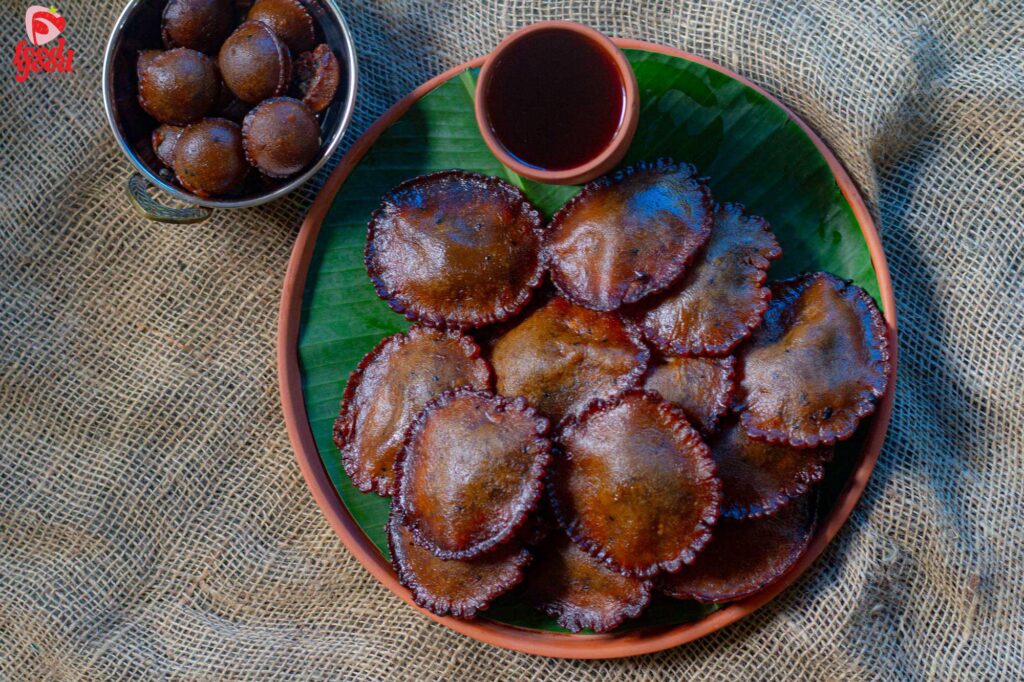Neyyappam is one of those snacks that speaks in a quiet voice. Not flashy, not festive – but familiar. The kind of snack you find in a tea stall behind a misty glass shelf, or on a banana leaf at home, still warm, waiting beside a glass of tea.
It begins the night before. Raw white rice – pachari – is washed and soaked overnight. In the morning, it’s ground to a smooth batter, then mixed with melted jaggery, mashed ripe banana, thin strips of fresh coconut, a pinch of cardamom powder, and black sesame seeds. The ingredients come together easily – just stirred with care.
Some use rice flour instead of soaked rice. If so, it must be unroasted – and sieved well, to remove coarse bits. The batter should be smooth and slightly thick, not gritty. That’s what gives Neyyappam its soft, even crumb inside.
Then, you wait. The batter rests for at least two hours. This step matters. The sweetness settles. The texture deepens. Everything begins to belong together.
When the oil is hot – with a spoon of ghee added – the batter is poured gently. It spreads, puffs, and crisps at the edges. The smell of jaggery and coconut fills the kitchen, thick and warm.
Each Neyyappam turns deep golden brown, with the edges crisp, the centre tender, and bits of coconut just barely toasted. The first bite is soft. Then the flavour unfolds – jaggery, banana, cardamom – everything in balance.
It’s not festival food. It’s home food. Something made when the day allows, when the mood is right, and when someone says, “It’s been a while.”
Neyyappam doesn’t need to impress. It just needs to be made with care – soaked rice, or good flour, a patient hand, and the kind of silence that usually fills a kitchen right before the oil starts to bubble.
Neyyappam
Description
Neyyappam is a sweet rice-based fritter fried traditionally in ghee. It originates from Kerala and is a popular teatime snack.
Ingredients
Instructions
-
Soak 2 cups of white raw rice (pachari) for about 2 to 3 hours.
-
Drain the water completely and grind the rice into a fine flour.
-
Sieve the flour to remove any coarse particles and keep it aside.
-
Melt 1½ cups of jaggery using a tablespoon of water.
-
Strain the jaggery syrup to remove impurities and let it cool.
-
In a mixing bowl, combine the rice flour and jaggery syrup.
-
Add enough water to make a smooth batter with a pouring consistency.
-
Add one tablespoon of mashed ripe banana to the batter along with a teaspoon of cardamom-sugar mix.
-
Mix well, cover, and let the batter rest for about 2 hours.
-
Heat 2 to 3 teaspoons of ghee in a pan and fry ¼ cup of coconut strips until they turn light brown.
-
In the same ghee, roast black sesame seeds and keep them aside.
-
Just before frying, add the fried coconut strips and roasted sesame seeds into the rested batter and mix well.
-
Traditionally, neyyappam is fried in pure ghee (hence the name-neyy means ghee in Malayalam). Here, we are using coconut oil.
-
Heat the oil on medium flame. Pour a ladle of batter into the hot oil.
-
Wait until the appam floats to the top, then turn it over and fry both sides until golden brown with a crisp crust.
-
Remove from the oil and place on a tissue or strainer to remove excess oil.
-
That’s it-Neyyappam is ready. Store in an airtight container and enjoy it with a cup of warm tea. It stays good for 2 to 3 days.


